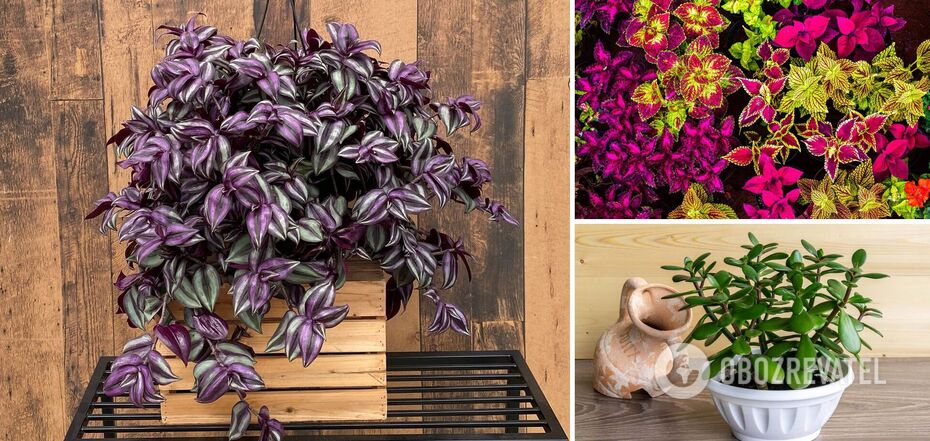Life
What houseplants to get rid of: spoil the interior and age quickly
Caring for indoor plants is an activity with many nuances that affect the appearance of your home garden, its splendor and ability to bloom. Some potted plants require special attention, as they can quickly age and lose their attractive appearance. So, what plants can spoil the interior?
OBOZREVATEL has compiled a list of these plants. Some of them are very hardy, but still lose their appearance and can spoil the interior if not properly cared for. The easiest way out of the situation is to give them to someone so that they don't hurt your eyes. However, they can be reanimated if you wish. We will tell you how.
Tradescantia
This plant is very unpretentious and can grow both in well-lit rooms and in the twilight. But in the shade, its striped leaves lose their brightness and look a little faded and not so contrasting. In addition, without careful care, tradescantia, although it grows well, still does not produce the lush foliage that is expected of it. This is solved by planting several plants in one pot. They will get along quite well in such conditions. And they will look especially impressive in a hanging planter.
Schlumbergera
Another name for this plant is the Christmas cactus, because this succulent blooms with beautiful bright pink flowers for the winter holiday season. However, amateurs also have species of other colors. Then it is really hard to look away from the plant, it looks so luxurious. For the rest of the year, Schlumberger, like most cacti, looks rather modest. In addition, it has not very bright greenery, which can collect dust - this problem is solved by "bathing" the plant.
Crassula, aka jade plant, aka money tree
Another succulent on our list, which is almost impossible to kill with poor care - this is the secret of the plant's popularity. Crassula really looks like a tree with thick, shiny dark green leaves. But there is one problem - if you do not water it often enough, the whole crassula will not die, but its leaves will wrinkle and begin to fall off. It is also sensitive to excessive watering. Also, over time, the greenery of the crassula darkens, so the plant needs to be rejuvenated from time to time - cut off the branches in the last days of winter. The advantage is that the restoration of proper watering can restore the plant to its spectacular appearance, and rejuvenation at least once every few years allows you to form a beautiful lush crown. Crassula can thank you for this with abundant, although not too ostentatious flowering.
Ficus elastica
This plant, after being brought from the Indonesian islands to Europe, has become incredibly popular. Ficus elastica looks very impressive thanks to its large bright leaves, besides, there are decorative species with spotted greenery, and it is perhaps the easiest of all ficuses to care for. The plant's fault lies in the fact that at one time it became too popular and was considered a sign of lack of taste. So, if you are sensitive to such statements, then look for something else to bring home. If not, you should know that nowadays the rubber-bearing ficus is once again entering the trends of indoor landscaping.
Coleus
Ornamental nettle grows well both in home flowerpots and flower beds. Plant lovers appreciate it for its colorful foliage, which, depending on the species, has a huge palette of shades that can be combined in compositions. It is quite easy to care for coleus - just do not put it in bright light and water it regularly. It will thank you for this with rapid growth and quickly turn into a lush bush. So this growth at home will have to be restrained by pruning. Also, with insufficient watering, the plant can become thin and drop its leaves. On the plus side, timely pruning gives the coleus a fresh and vibrant look, and the problem with the leaves can be solved by simply watering the flowerpot abundantly.
Sansevieria
Some snobs also dislike this unpretentious plant with hard leaves because of its incredible popularity. It's just that sansevieria does not require careful maintenance and rarely anyone manages to bring it to a "non-commodity" appearance, so even people who are not inclined to grow greenery decorate their homes with it. In addition, plants of this species come in very different forms - from tall striped leaves, which are popularly nicknamed "mother-in-law's tongue," to low dark green spotted rosettes. From wide leaves to tube leaves. Like crassula, sansevieria can shrivel from too little watering. If the damage is minor, it is treated by resuming watering. If the leaves are severely damaged, you can simply cut them off - the plant is very resilient and will soon produce new ones.
Only verified information is available on the Obozrevatel Telegram channel and Viber. Don't fall for fakes!



























